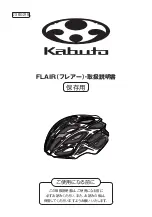
©Eastman Kodak Company, 2007
November 2008
•
H-1-5302
TECHNICAL DATA /
BLACK-AND-WHITE PRINT FILM
EASTMAN Fine Grain Release
Positive Film 5302 / 7302
EASTMAN Fine Grain Release Positive Film 5302 (35 mm)
and 7302 (16 mm) is a low speed, high-resolution print
film. This blue-sensitive black-and-white film is designed
for general release printing. It is also useful for making
both positive and negative titles, and for dubbing prints for
sound.
BASE
This film has a clear acetate safety base with an anti-static
protective layer. The base thickness is 5.6 mils. In addition,
7302 Film has an anti-curl layer applied to the base.
DARKROOM RECOMMENDATIONS
Use a KODAK OC Safelight Filter / greenish-yellow, with a
15-watt bulb, no closer to the film than 1.2 metres (4 feet).
STORAGE
Store
unexposed film
at 13
°
C (55
°
F) or lower. For extended
storage, store at -18 C (0
°
F) or lower. Process exposed film
promptly. Store
processed film
according to the
recommendations in NAPM IT9.11-1992: for medium-term
storage (minimum of ten years), store at 25
°
C (77
°
F) or
lower at a relative humidity of 20 to 50 percent; for
extended-term storage (for preservation of material having
permanent value), store at 21
°
C (70
°
F) or lower at a
relative humidity of 20 to 30 percent. For active use, store
at 25
°
C (77
°
F) or lower, at a relative humidity of 50
±
5
percent. This relates to optimized film handling rather than
preservation; static, dust-attraction and curl-related
problems are generally minimized at the higher relative
humidity. After usage, the film should be returned to the
appropriate medium- or long-term storage conditions as
soon as possible.
For more information about medium- and long-term
storage, see NAPM IT9.11-1992, and KODAK Publications
No. H-1,
EASTMAN Professional Motion Picture Films
and No.
H-23,
The Book of Film Care
.
PRINTER CONDITIONS
You can make satisfactory prints using negatives of
average density if run on a continuous additive printer
(such as the Bell & Howell Model C) run at 180 ft/min, and
equipped with a 1000-watt lamp operated at 80 volts (85
volts for 35 mm), and a ground glass in the beam. Typical
starting-point printer settings are as follows:
For laboratories with subtractive printers, such as a Bell
& Howell Model J Printer, the following recommendations
should be helpful as a starting point: 1000-watt lamp at 55
volts and a printer speed of 62 feet per minute for 16 mm
film. For 35 mm film, using a Bell & Howell Model D
Printer: 500-watt lamp at 75 volts and 90 feet per minute.
For both 16 and 35 mm setups use a neutral density filter
(such as the KODAK WRATTEN Neutral Density Filter,
No.96) with a density of 0.50 in the beam and a diaphragm
setting of 13.
SOUND TRACK PRINTING
A variable-area positive silver sound track can be printed
on 5302/7302 Film from a negative sound record on
EASTMAN EXR Sound Recording Film 2378/3378. The
optimum variable-area sound track density for the print
lies between 1.2 and 1.4, measured visually for both 16 and
35 mm films. This print density is chosen to provide a good
compromise between signal-to-noise ratio and frequency
response. The densities of the sound-track negatives
required to produce optimal print densities are determined
by using recognized cross-modulation test procedures.
Beam
Trim Setting
Tape Setting
16 mm
35 mm
16 mm
35 mm
Red
17
21
32
24
Green
17
21
32
24
Blue
17
21
32
24






















